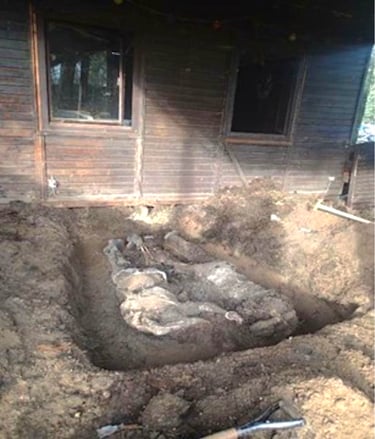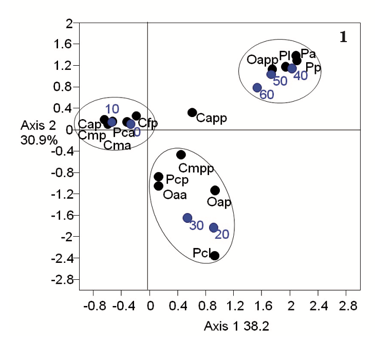Shallow and Mass Grave Forensics
Perotti MA, Pashkova O, Braig HR. 2023
Mass graves constitute a unique niche for forensic biological traces.
In: Актуальні Питання Судової Експертизи і Криміналістики [Current Issues of Forensic Examinations and Criminalistics]; Tyuleniev S, editor. Pravo Publishing House of the National Academy of Legal Sciences of Ukraine and Yaroslav the Wise National University of Law, Kharkiv; 27-31.
Modern mass graves, grave pits, and sites of mass burials are investigated widely [1, 2]. Examples of the survey of historical mass grave sites carried out by Ukrainian researchers range from the late Roman time near Komariv in Middle Transnistria [3], the Netaylovka cemetery of the Saltovo-Mayatskoe culture of the 8th and 9th Centuries [4], to the early medieval necropolis of Shestovytsia in Chernigov, Ukraine [5].
Recent studies are showing that mass graves are in many ways different from single graves. The increasing use of simulated mass graves including ones containing human remains, is driving research that reveals these differences. Geophysical imaging using ground penetrating radar (GPR), electrical resistivity tomography (ERT), and electromagnetics (EM) show that physical properties of the soil differ between mass graves and individual burials [6—9]. ERT showed still differences to the surrounding environment after 8 years of burial in southwestern Nigeria [10]. Thermal imaging detects mass graves in arid environments for 7 months [11]. The dynamics of gases emitted by mass graves causes changes in soil pores [12]; the microbiology alters as well [13], so does the chemistry of the soil [14]. Surface anomalies such as differences in vegetation can last for more than 3 years [15].
Mass graves are characterized by differential decomposition or differential preservation, also known as the feather(ed) edge effect, where decomposition progresses much faster at the periphery leading to the skeletonization of corpses while in the centre of the mass grave, the soft tissue of corpses is still well preserved [16—21]. The misinterpretation of differential decomposition in a mass grave by the defence in the trail of Radovan Karadžić is exemplified in Barker, Alicehajic and Naranjo Santana [16].
Adipocere persists longer in mass graves than in single graves [22—25]. Brain tissue is one of the soft tissues to autolyse first and most completely during decomposition [26]. Yet, there are many reports about the preservation of the brain where other soft tissues have gone [27—29]. We propose that preservation of the brain is much more common in mass graves than in individual graves [30—32].
Rai J K, Pickles B J, & Perotti M A. 2022
The impact of the decomposition process of shallow graves on soil mite abundance.
Journal of Forensic Sciences 67, 605-618.
Burial of a cadaver results in a slower decomposition rate, due to more stable below-ground temperatures and restricted access to necrophagous insects. In such circumstances, analysis of the soil mesofauna, with emphasis on mites (Acari) may be more valuable in time-of-death estimations. The production of volatile organic compounds of cadaveric decay results in changes, especially in the soil pH, which in turn would affect the abundance and diversity of the associated mites. In general, the effects of decomposition and the consequently altered pH levels on the abundance of mites in shallow graves, as well as the effects of fluctuating above-ground environmental parameters (temperature, relative humidity, and precipitation) remain unknown. Here, we found that the decay of three pig cadavers buried in shallow graves (<30 cm below) caused a significant increase in the soil pH throughout decomposition, from neutral to alkaline. Cadaver decay attracted an abundance of mites: with 300 mites collected from the three pig cadavers compared to 129 from the control soil samples at the same depth. Mites rapidly became more abundant in cadaver-associated soils than in control soils after the fresh stage. Increasing soil pH had a positive impact on the abundance of mites in graves and there was a significant interaction between cadaver body temperature and soil pH. Above-ground fluctuations in temperature, relative humidity, and precipitation were found to have no significant direct effect on mite abundance in grave or control soils.
Perotti M A & Braig H R. 2022
The arthropods of corpses from above ground and from deep below.
Zoosymposia 22, 149-152.
The Acari are one of the most ubiquitous arthropod inhabitants and associates of human and animal remains. Over 150 years ago, Jean Pierre Mégnin proposed that mites arrive at corpses at two particular stages of the decomposition process, that is within the first and the sixth waves of arthropod arrival or colonisation event (Mégnin, 1895). Now we know that mites actually arrive at each stage of the decomposition process of corpses, in a continuum (Rai et al., 2021). Interestingly, the mite fauna of cadavers is very diverse, and mite species composition varies as decomposition progresses and according to the environment where decomposition occurs (Baker, 2009; Braig & Perotti, 2009). In fact, specific stages of decomposition can be characterised by the associated mite species (Kamaruzaman et al., 2018; Leclercq & Verstraeten, 1988; Mašán et al., 2013; Mégnin, 1895).
In terms of the environment where a corpse decomposes, if on a soil surface, outdoors, it will attract epigeal and hypogeal mites and a variety of carrion insects, which will bring their own phoretic mites (Fig. 1-A). Mites travelling on insects or small rodents are the most common and ubiquitous arthropods arriving on remains (Perotti & Braig, 2009; Perotti et al., 2010). Some carrion insects, like beetles, are able to transport several species and a great number of individuals, up to the hundreds or thousands. For example, silphid beetles are able to bring species of Parasitidae, Macrochelidae, Melicharidae, Uropodidae, Histiostomatidae, Acaridae at the same time—just to name some of the most common families of phoretic mites brought to a corpse (Perotti & Braig, 2009).
Opportunistic insects visiting or colonising, somehow taking advantage of the corpse (Byrd & Castner, 2009), for example, a queen bumblebee using part of it to build its nest, will bring too its diverse phoretic mites (Klimovet al., 2016).Ticks, although opportunistic, are also assiduous visitors of the decomposition environment (McNemeeet al., 2003). They need to be nearby, ready to jump on the next host approaching the decomposed body, likely a scavenger or a forensic investigator. This is becoming so frequent that in Europe, the widespread speciesIxodes ricinusutilises carrion and coprophagous beetles moving to and from carcasses to secure availability of hosts (Salona-Bordaset al., 2015).
Rai J K, Pickles B J, & Perotti M A. 2021
Assemblages of Acari in shallow burials: Mites as markers of the burial environment, of the stage of decay and of body-cadaver regions.
Experimental and Applied Acarology 85, 247-276.
The burial of a cadaver results in reduced arthropod activity and disruptions in colonisation patterns. Here, the distribution and diversity of mite taxa was studied across decomposition stages of shallowly buried pig carcasses (Sus scrofa domesticus). In total 300 mites (88 species) were collected from three pig shallow graves compared to 129 mites (46 species) from control (bare) soil samples at the same depth. A successional pattern of Acari higher taxa and families was observed, and species richness and biodiversity fluctuated throughout decomposition, whereas active decay showed the greatest biodiversity. Mesostigmata mites were the most abundant in ‘cadaver soils’ with a significant difference in the abundance of Parasitidae mites, whereas Oribatida mites (true soil mites) were the most abundant in control soils. Certain mite species were significantly associated with decay stages: Cornigamasus lunaris with ‘bloated’, Gamasodes spiniger with ‘active’, Eugamasus sp. and Lorryia reticulata with ‘advanced’, and Macrocheles matrius and Ramusella clavipectinata in ‘dry’. Scheloribates laevigatus was a marker of bare soil at a shallow depth and Vulgoramasus remberti of buried decomposition, not specific to any decay stage. Analysis of mite assemblages associated with head, torso and posterior body showed that Parasitus evertsi and M. matrius are attracted to beneath the thighs, whereas L. reticulata to beneath the head. This study highlights the value of mites as indicator species of decomposition and its stages, confirming (1) a succession of Acari on buried remains and (2) species specificity to body regions.
Rai J K, Amendt J, Bernhardt V, Pasquerault T, Lindstrom A, & Perotti M A. 2020
Mites (Acari) as a relevant tool in trace evidence and postmortem analyses of buried corpses.
Journal of Forensic Sciences 65, 2174-2183.
This report interprets the presence of mite species in three clandestine graves in Europe, evaluating their potential use as trace evidence or markers. Grave 1 (Sweden): Two mite species Rhizoglyphus robini Claparède, 1869 and Parasitus loricatus (Wankel, 1861) were recovered from the surface of a body buried in a shallow grave in an area surrounded by trees, in close vicinity to house gardens. Grave 2 (Germany): Phoretic deutonymphs of Gamasodes spiniger (Trägårdh, 1910) were attached to an adult fly (Diptera: Sphaeroceridae) found within a shallow grave containing two human bodies covered in soil and dung. Grave 3 (France): P. loricatuswere recovered from the soil around a body buried in a deep grave (80 cm under). In graves 1 and 3, both corpses were undergoing advanced decay and skeletization, the locations match with the subterranean habit of P. loricatus, highlighting the value of this species as a marker of graves or burials in soil and during late decomposition. R. robini is a soil mite that feeds on decayed roots and bulbs; this mite species confirms the location of the corpse within top soil, agreeing with a more specific type of superficial burial, a shallow grave. In case 2, the presence of both coprophiles, the mite G. spiniger and the carrier fly confirm association of remains with dung or animal feces. The three mite species are reported for the first time in human graves. There are no previous records of R. robini from Sweden.
Marchiori JI, Mansegosa DA, Giannotti S, Fernández Aisa CA, Jofré FN, & Aballay HF. 2022
Carroñeo de cadáveres humanos: Aportes desde la tafonomía y la entomología a causas forenses (Mendoza, Argentina) [Scavenging of human corpses: Contributions from taphonomy and entomology to forensic causes (Mendoza, Argentina)]
Intersecciones en Antropología 2022, 53-65.
The scavenging of human corpses is one of the most common and destructive taphonomic processes that affect outdoor forensic contexts. Despite being one of the main problems for forensic investigations, however, there are few publications on this topic in South America. The degree of alteration produced varies in relation to multiple factors, which is why actualistic studies provide valuable information due to their specificity. In this article, two forensic cases of human corpses affected by carnivores found in the province of Mendoza, Argentina, are presented. The disarticulation, dispersion, differential bone preservation, and marks produced are described taphonomically in each case. In addition, entomological analysis is incorporated to discuss the postmortem interval and to better understand the find contexts. The results show the negative impact of scavenging for the reconstruction of the osteobiographic profile, the evaluation of the cause of death, and the identification of the cause of death. The importance of the presence of specialized personnel to maximize the recovery of evidence in complex outdoor scenarios is highlighted.
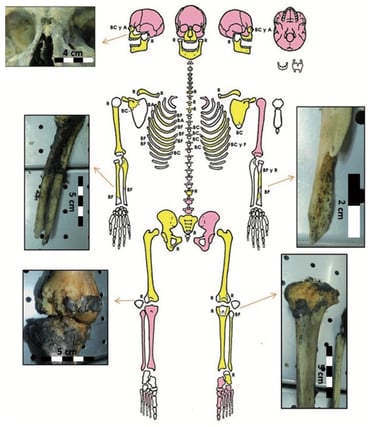

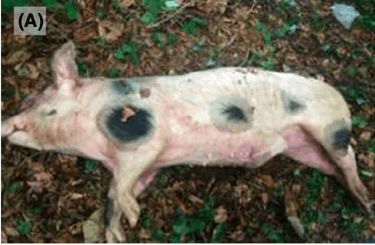

Mansegosa DA, Giannotti PS, Marchiori JI, Jofré FN, Aballay HF, & Fernández Aisa C. 2021
The story of a homicide: The location, exhumation, and multidisciplinary analysis of a clandestine burial.
Forensic Science International: Reports 3, 100165.
This article presents a case study of a victim murdered in 2008 and found in a clandestine burial. The body was found in 2019 outside a rural residence in the province of Mendoza, Argentina. The article’s objective is to demonstrate the relevance of having archaeologists and anthropologists on-site and the importance of multidisciplinary laboratory analysis as part of a continuous process of investigation. The search, location, exhumation, and interpretation of the burial was carried out using archaeological methods. In the laboratory, we reconstructed the biological profile and cause of death using forensic anthropology, dentistry, image diagnosis, and genetics. The postmortem interval and history were reconstructed from the entomological and taphonomic analyses. The individual’s identity was confirmed and the evidence made it possible to locate and prosecute those responsible for the murder. Finally, the classic indicators of burial are discussed in relation to those found in the case study presented here. The unsystematic techniques used by the scientific police in cases of buried corpses are also critically assessed. We reflect on the importance of collecting adequate scientific evidence to support a legal case.
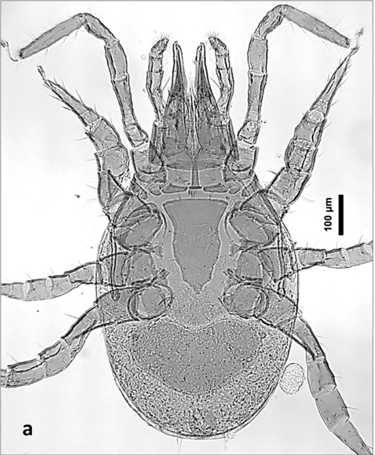

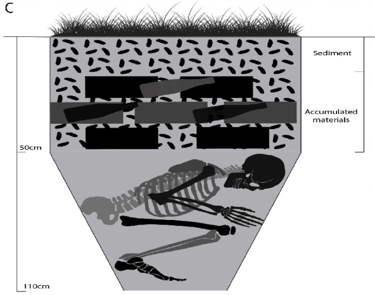

Aballay FH, Jofré FN, & Centeno ND. 2017
Asociación y estratificación de la entomofauna cadavérica a diferentes profundidades en el suelo como indicadores complementarios en largos intervalos post mortem [Association and stratification of cadaveric entomofauna at different depths in the ground as complementary indicators in long post-mortem intervals].
Revista del Museo Argentino de Ciencias Naturales 19, 225-234.
In this study the composition of carrion entomofauna in the ground below the carcass one month after the death was examined, identifying strata and associations to different ground depths. three carcasses were examined: two horses and a cow, placed in sandy soil during the spring, summer and autumn in a natural environment in Mendoza. Soil samples were taken from ground surface every 10 cm below the corpse up to a depth of 60 cm. A total of 11,452 specimens (8,576 in autumn, 2,339 in summer, and 537 in spring), belonging to 24 different species belonging to 11 families were collected. Indicator species allowed differentiation of strata in sampled soil under corpses. In spring a first stratum was defined with pupae of Piophila casei (Linnaeus) (Piophilidae) between the surface and 30cm depth and a second stratum was defined at a depth between 40 to 60cm with pupae of a species of Phoridae and eggs of Histeridae. In summer only one stratum was defined by the abundance of puparia of Chrysomya albiceps (Wiedemann) (Calliphoridae), located between the surface and 30cm depth. In autumn only one stratum was determined by larvae of Dermestes maculatus de Geer (Dermestidae) located between the surface and 20 cm depth. The entomological composition varies with depth and between seasons, abundance was higher on the surface. Calliphoridae and Dermestidae were associated with superficial layers and the genera Euspilotus Lewis (Histeridae) and Omorgus Erichson (Trogidae) to deeper layers of the soil.
